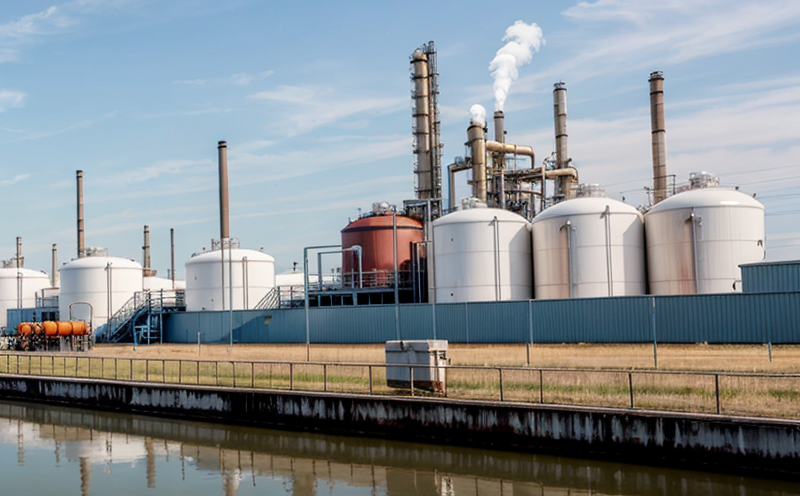ASTM D2579 Corrosivity Safety Testing in Industrial Water
The ASTM D2579 standard specifies the procedure for determining the corrosive effects of industrial water on metal specimens. This testing is critical for industries that rely on large-scale water systems such as power generation, petrochemical processing, and manufacturing facilities. Ensuring the quality and safety of industrial water not only prolongs equipment lifespan but also prevents costly disruptions in production.
The test involves exposing various metals to a known volume of industrial water under controlled conditions for a specified duration. After exposure, the specimens are evaluated based on visual inspection, mass loss determination, and other quantitative methods as outlined by ASTM D2579. This procedure allows quality managers and compliance officers to assess the corrosivity risk associated with specific water sources.
Corrosion can lead to significant economic losses due to premature equipment failure, increased maintenance costs, and potential safety hazards. By conducting ASTM D2579 testing, industries can identify potential issues early on, enabling them to implement corrective measures such as chemical treatment or process modifications.
The test procedure is designed to simulate real-world conditions encountered in industrial water systems. Specimens are typically made from common materials like carbon steel, stainless steel, aluminum, and copper alloys, which are representative of the types used in various industrial applications. The selection of specimens ensures that the results accurately reflect the corrosive behavior under actual operating conditions.
The testing process involves several key steps:
- Preparation of metal specimens according to ASTM D2579 specifications
- Selection of appropriate industrial water samples for testing
- Exposure of specimens in controlled environmental chambers
- Measurement of mass loss and visual inspection after exposure duration
The results are then analyzed using internationally recognized standards, such as ASTM D2579, which provide clear criteria for evaluating the corrosivity risk. Compliance officers can use these data to ensure that water quality meets regulatory requirements and industry best practices.
| Application | Description |
|---|---|
| Petrochemical Processing | Evaluating the corrosive effects of industrial water on equipment used in refining processes. |
| Power Generation | Determining the impact of cooling tower and boiler feedwater on metal components. |
| Manufacturing Facilities | Assessing the suitability of process water for use in various manufacturing operations. |
| Mining Operations | Identifying corrosion risks associated with water used in mining and ore processing. |
The ASTM D2579 procedure is widely recognized for its reliability and accuracy. It has been adopted by numerous industries to ensure the safety and longevity of equipment exposed to industrial water. By adhering to this standard, organizations can mitigate risks associated with corrosive environments and maintain efficient operations.
Benefits
The benefits of ASTM D2579 testing are numerous and far-reaching. For quality managers and compliance officers, it provides a standardized method for assessing the corrosivity risk of industrial water. This allows them to make informed decisions regarding water treatment and equipment selection.
R&D engineers can leverage the results of ASTM D2579 testing to innovate and improve processes. By identifying areas where corrosion is likely to occur, they can design more resilient systems that withstand harsh environmental conditions.
For procurement teams, this test ensures that the water used in production meets strict quality standards set by industry leaders like ASTM. This reduces the risk of equipment failure and extends the operational life of critical components.
The data generated from ASTM D2579 testing can also help organizations comply with regulatory requirements and maintain a high level of safety within their facilities. By adhering to this standard, companies demonstrate their commitment to excellence in quality control and compliance.
Industry Applications
- Petrochemical Processing: Evaluating the corrosive effects of industrial water on equipment used in refining processes.
- Power Generation: Determining the impact of cooling tower and boiler feedwater on metal components.
- Manufacturing Facilities: Assessing the suitability of process water for use in various manufacturing operations.
- Mining Operations: Identifying corrosion risks associated with water used in mining and ore processing.
The ASTM D2579 procedure is widely recognized for its reliability and accuracy. It has been adopted by numerous industries to ensure the safety and longevity of equipment exposed to industrial water. By adhering to this standard, organizations can mitigate risks associated with corrosive environments and maintain efficient operations.
Quality and Reliability Assurance
The ASTM D2579 procedure ensures that testing results are consistent and reproducible across different laboratories. This is achieved through strict adherence to the standard’s procedures, including specimen preparation, exposure conditions, and evaluation methods. By following these guidelines, laboratories can provide accurate and reliable data that meet industry expectations.
Laboratories using ASTM D2579 must have the necessary facilities and equipment to conduct the tests. This includes environmental chambers capable of maintaining precise temperature and humidity levels, analytical balances for mass loss measurement, and visual inspection tools like magnifying glasses or microscopes. The use of calibrated instruments ensures that all measurements are accurate and repeatable.
The proficiency of the laboratory personnel is also crucial in ensuring reliable results. Trained technicians who understand the nuances of ASTM D2579 testing can perform specimen preparation accurately, monitor exposure conditions closely, and conduct thorough evaluations. Regular calibration of equipment and ongoing training for staff further enhance the quality and reliability of test results.
Quality assurance measures extend beyond individual tests to include continuous improvement efforts. Laboratories that adopt a culture of quality continually review their processes, seek feedback from clients, and implement changes based on best practices and emerging standards like ASTM D2579.





